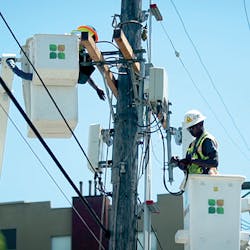What Providers Should Consider When Working With Wireless Construction And Engineering Partners
Wireless engineering and construction are in high demand as the nation races to build out its 5G network. According to a report by the Global Systems Mobile Association (GSMA), an organization representing over 750 operators worldwide, the number of devices connected to the Internet will triple by 2025, reaching 25 billion. It is expected that only 1/4 of 5G’s full potential will be reached by the end of 2021.
Indeed, carriers have a lot of work ahead of them to maximize the full capabilities of 5G and make it a reality for communities across the U.S. For this to be accomplished in a timely and strategic fashion, carriers should seek out true end-to-end partners with dedicated teams for each stage of the project. Having full accountability in a one-stop-shop has huge advantages for carriers including transparency, communication and cross-functional partnerships.
Toward this end, there are a number of best practices to consider. Below are key processes carriers, owners and integrators should consider throughout the development and construction process. Believe it or not, it’s more about the diligent practice of healthy COMMUNICATION than you might believe.
Construction Management Starts Early
Consider bringing in a construction management (CM) team during the initial planning phase of your project – even as early as site selection.Having a construction manager involved from pre-construction through deployment can streamline a project and help avoid obstacles before they arise.With a CM managing the big picture, an 18-month design timeline can be reduced to seven months in some cases. This can help save time, money and headaches.
Without oversight during the initial design, there are many opportunities to miss significant components that will make the build successful or result in change orders and/or delays in construction. General Contractors (CGs) and CMs have the expertise to implement precise details and identify inconsistencies that can potentially lead to delays of on-air dates.
Tip #1: Remember to share the overarching goals of the project including build plan, budget, accessibility, material availability and timeline with your CM team managing the end-to-end process. Understanding the objectives will help the team troubleshoot and prioritize as the project advances.
Site Acquisition Starts Even Earlier
When it comes to site acquisition, alignment with the project’s RF engineers and development team is fundamental. Begin with expectations that reflect the needs of the given location from an equipment standpoint, and what is achievable in that jurisdiction.
Our societies and the cultural landscape are ever evolving. Therefore, it is important to take a new approach to develop long-term relationships with the jurisdictions in which you are working. Partners you align with should have internal permit expediters who build long-term relationships with jurisdictions to better execute the approval process that has traditionally been lengthy and heavily regulated.
When using an end-to-end integrator, be sure to share key information across departments. Information is typically shared with the site acquisition team and the construction team. Forgetting what seems like ‘unimportant’ information could potentially affect your long-term landlord relationships and future lease negotiations. Upholding these relationships is crucial with firms that have a large real-estate footprint.
Tip #2: Prevent departmental and informational black holes. OVER-communicate if necessary.
Engineers Need To See The Forest And The Trees
For the engineering team, it is important to have as much information in the beginning as possible. Include detailed site information, as-builts, final Radio Frequency Data Sheet and all jurisdiction insight. Allow the engineers to get on site as early as possible for site-walks to help collect any addition information that could influence the design.
During the construction process, the architecture and engineering team needs to stay in close contact with the GCs. And because the GC have the best view of any pre-constructed mounts, they should alert the engineering team about the condition of existing structural parts. This helps identify any structural faults including, rust, loose bolts, bent flanges or missing washers that would affect the integrity of the structure.
Tip #3: Use the Cloud to record ‘gotchas’ like structural faults. Then, share this with everyone involved. Contrary to popular thought, engineers can’t read minds.
Don’t Make Assumptions About Construction Safety
It’s critical that all team members follow regulations and OCHA guidelines. It is also imperative to avoid presumptions. Toward that end, be sure to always state details in your calls, and follow up with written correspondence. Keep in mind material availability and lead times to avoid any delay.
Site requirements vary, whether a hospital, corporate building or small cell on the street. So, having a complete understanding of the safety code requirements in each jurisdiction will dictate the construction requirements. Keep the construction team in close contact with the engineers because what is on location is not always reflected in the CAD drawings and vice versa.
Tip #3: Since every project has unique challenges ranging from civil engineering and propagation to landscape, the engineering and construction teams should be in constant communication. These are the experts who are highly skilled in safety, troubleshooting, problem-solving and custom fabrication. They can help avoid problems that could set back the project’s on-air date.
Deployment Is All About The Details
At the final stage of the project, you want to see your signal go live without any shortcomings, interruptions or interference. Undoubtedly, communication across departments and phases of the project can significantly impact the timeline and quality of work.
Working with a team that has end-to-end abilities, high quality standards and jurisdiction relationships will keep projects organized and streamlined for the most efficient project execution.
Tip #4: Partner with a dependable team that offers proven experience, technical insights, and critical skills needed to tackle unforeseen obstacles. Then, communicate with each of the contracted team as if you would communicate with your internal team members. Your project’s life depends on it.
For more information, please email [email protected]. To learn more, visit https://leafcomm.com/ or visit https://leafcomm.com/#contactus.





